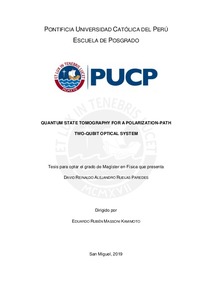| dc.contributor.advisor | Massoni Kamimoto, Eduardo Rubén | |
| dc.contributor.author | Ruelas Paredes, David Reinaldo Alejandro | es_ES |
| dc.date.accessioned | 2019-05-02T23:07:13Z | es_ES |
| dc.date.available | 2019-05-02T23:07:13Z | |
| dc.date.available | 2019-05-02T23:07:13Z | es_ES |
| dc.date.created | 2019 | es_ES |
| dc.date.issued | 2019-05-02 | es_ES |
| dc.identifier.uri | http://hdl.handle.net/20.500.12404/14117 | |
| dc.description.abstract | En el área de los sistemas cuánticos abiertos, es común encontrar experimentos
y modelos teóricos en los que el sistema de interés es representado por un cubit
(sistema de dos niveles) y el entorno por otro cubit pese a que un entorno realista
debería contener muchos más grados de libertad que el sistema con el que interactúa.
No obstante, la simulación de entornos mediante un cubit es usual en la óptica
cuántica, como también lo es la realización de evoluciones de sistemas de dos cubits.
Los procedimientos utilizados para caracterizar los estados cuánticos producidos
en el laboratorio son conocidos como tomografía de estados cuánticos. Existen
algoritmos de tomografía para distintos tipos de sistemas. En esta tesis presentamos
un dispositivo interferométrico que permite generar y hacer tomografía a un estado
puro de un sistema de dos cubits: polarización y camino de propagación de la
luz. Nuestra propuesta requiere 18 mediciones de intensidad para caracterizar cada
estado. Ponemos a prueba nuestra propuesta en un experimento y contrastamos sus
resultados con las predicciones teóricas. | es_ES |
| dc.description.abstract | In the field of open quantum systems, we usually find experiments and models in
which the system is represented by a qubit (two-level system) and its environment by
another qubit even though a realistic environment should contain many more degrees
of freedom than the system it interacts with. However, these types of simulations
are common in quantum optics, as are models of two-qubit system evolutions. The
procedures that characterize quantum states produced in a laboratory are known
as quantum state tomography. Standard tomography algorithms exist for different
types of systems. In this thesis we present an interferometric device that allows us
to generate and perform tomography on a pure polarization-path two-qubit state.
18 intensity measurements are required for characterizing each state. We test our
proposal in an experiment and compare the results with the theoretical predictions. | es_ES |
| dc.language.iso | eng | es_ES |
| dc.publisher | Pontificia Universidad Católica del Perú | es_ES |
| dc.rights | info:eu-repo/semantics/openAccess | es_ES |
| dc.rights.uri | http://creativecommons.org/licenses/by-nc-sa/2.5/pe/ | * |
| dc.subject | Mecánica cuántica | es_ES |
| dc.subject | Algoritmos | es_ES |
| dc.subject | Polarización (Física nuclear) | es_ES |
| dc.subject | Interferometría | es_ES |
| dc.subject | Lásers | es_ES |
| dc.subject | Teoría cuántica | es_ES |
| dc.title | Quantum state tomography for a polarization-Path Two-Qubit optical system | es_ES |
| dc.type | info:eu-repo/semantics/masterThesis | es_ES |
| thesis.degree.name | Maestro en Física | es_ES |
| thesis.degree.level | Maestría | es_ES |
| thesis.degree.grantor | Pontificia Universidad Católica del Perú. Escuela de Posgrado | es_ES |
| thesis.degree.discipline | Física | es_ES |
| renati.advisor.dni | 07465269 | |
| renati.discipline | 533017 | es_ES |
| renati.level | https://purl.org/pe-repo/renati/level#maestro | es_ES |
| renati.type | http://purl.org/pe-repo/renati/type#tesis | es_ES |
| dc.publisher.country | PE | es_ES |
| dc.subject.ocde | https://purl.org/pe-repo/ocde/ford#1.03.00 | es_ES |






